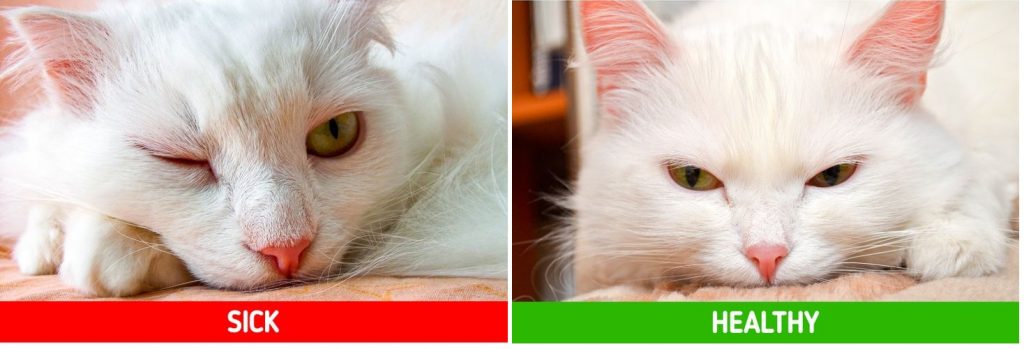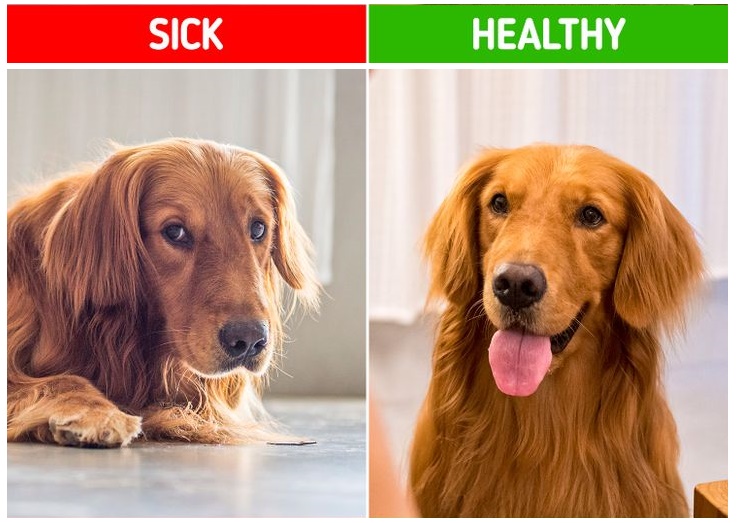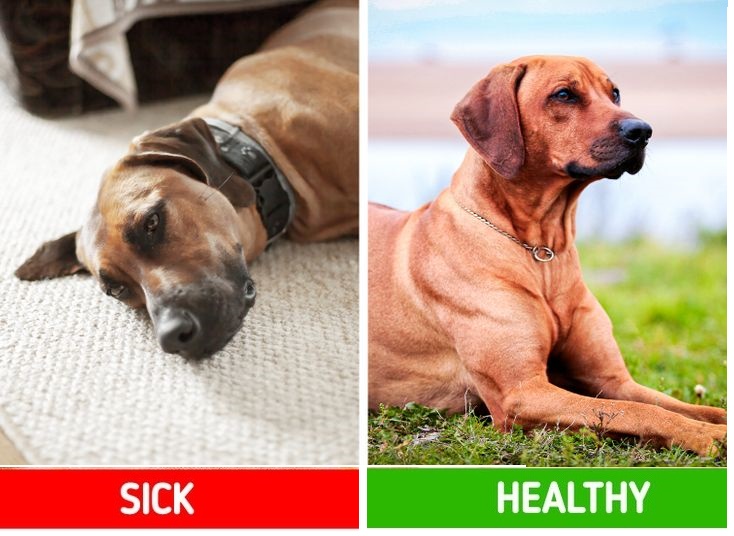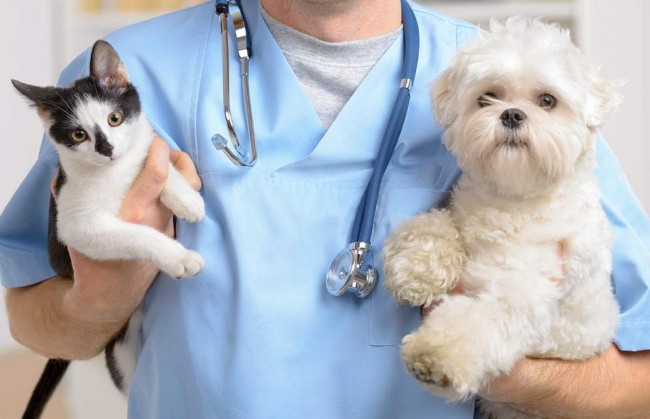1. Watery eyes and winking
If you see that your pet often has watery eyes and is constantly blinking, it could have an illness. In any case, we must be careful what can happen, because cats and dogs do not express their feelings through crying. Of course, this means it’s important to get your pet to the vet for a check-up as soon as possible.
If your cat often has watery eyes and you notice that he is starting to blink more than usual, he may have conjunctivitis, allergies, or even a foreign object in his eye. You should also look for red marks on his eyes.
If your dog has watery eyes, especially if they only have one, it can also be a sign of a corneal injury, conjunctivitis, allergies, tumors, or even a blocked tear duct.

2. Overdress his legs
If your pet constantly feels the need to lick or chew on their paws, they may experience annoying pain or itching in and around their claws. You really must be extra careful with your pet if you notice this habit becoming very constant as the days go by.
You probably know that cats have a habit of licking their paws every day, but you should be careful if they repeatedly lick their paws and the area around the claws turns red or starts shedding hair. This could indicate that he suffers from allergies, intolerances or parasites, among other things.
Dogs can have problems with their claws, especially if they change color or break easily. Conditions that can cause these symptoms can include allergies, tumors, or metabolic diseases.
3. Excessive drooling
It is common for some pets, such as Dogs, produce a lot of drool. However, if you notice that the amount of saliva your dog is producing is getting out of hand, you could be experiencing one of the first symptoms of illness. As with cats, visible salivation is always a clear sign that something is wrong.
In dogs, hypersalivation can be due to poisoning, foreign objects in the mouth, infection or stress, among other things.
In contrast, visible drooling in cats is never common and can be caused by infection, oral problems, stress, or salivary gland disease.
4. Weak or seemingly sad mood

Like humans, depression in pets is rarely talked about, although it is far more serious than just a bad mood or sad mood that you can shake off at will. It is a real disease, mostly treated covertly, which could prevent your pet from behaving normally.
If your dog exhibits depressive behavior that doesn’t go away after a short period of time, he could be suffering from depression from trauma, an underactive thyroid, fever, or cataracts, among other things.
When it comes to a cat, the sad mood can be linked to emotional issues, especially when it stops playing or adopting normal habits like sharpening its claws. There are several reasons why this could happen. Some of the most common are jealousy, stress, and anxiety. In any case, we are talking about a disease that can cause a lot of discomfort or even traumatic shock.
5. Sudden weight loss
Obesity isn’t the only weight-related issue that could threaten your pet’s health. Sudden weight loss in pets for no apparent reason can also be a clear sign of a serious underlying condition.
The causes of weight loss in pets should always be determined by a veterinarian after careful investigation to find out what is really going on. Some of the most common reasons for a pet to lose weight quickly are internal parasites, an overactive thyroid, cancer, or heart problems, so consult your veterinarian as soon as possible.
6. Constant scratching
Scratching is a normal habit in dogs and cats, which at first glance should not pose any risk to their health. However, if your pet not only constantly scratches, but also sheds hair on various parts of its body, then it may have an illness.
Dogs that are constantly itching and scratching can suffer from food allergies, dermatitis, fungal infections, or skin irritations, among other things.
Cats will often scratch or lick like there’s no tomorrow when they feel any part of their body itchy. It is normal. However, if he does this consistently for days, it could be a fungus, allergies, eye problems, or even an object stuck in the cat’s nose.
7. Absence of hair around the eyes
You should always watch out for hair loss in pets. If it occurs around the eyes, your pet could be suffering from a serious illness and should be checked out by a veterinarian as soon as possible.
If your dog has bald patches around their eyes and is accompanied by red spots, it could be due to dust mites, a weakened immune system, fungi, or allergies.
If your cat has lost hair around its eyes, it could be related to constant scratching, possibly caused by an itch or a specific nuisance. These, in turn, could be caused by conjunctivitis or even a foreign object that has gotten into the cat’s eye.
8. He doesn’t want to go for a walk or play at home.

When an animal refuses to participate in daily activities or even walk, it is most often due to joint inflammation which makes it very difficult for them to play or, in severe cases, to walk.
If your pet refuses to walk or has difficulty with simple physical activities, it could be a symptom of osteoarthritis, leg pain, or even a possible cruciate ligament tear in the knee, which can be very painful.
9. Constantly shakes his head or scratches his ear.
When an animal scratches its ears and frantically shakes its head, it’s a sure sign that something is going on in or around the ear area. Head movements that clearly indicate your pet is trying to dislodge something in their ear, or intense scratching in that area are reasons to see the vet. He or she will then examine your pet to determine exactly what the problem is.
Keep in mind that if your dog keeps shaking his head and scratching his ear or neck, this can indicate a foreign object in his ear, an ear infection, ticks, or bruises, among other things.
If your cat experiences discomfort in its ears and shakes its head constantly, this could be a sign that it has a foreign object in its ear, an infection, inflammation, ear infection, or allergy, among other possible causes.
10. Sudden and compulsive overeating
As with loss of appetite, pets can experience a type of anxiety that causes them to eat more food than they really need. It could also be a symptom of an underlying health condition in your pet. It is clear that there are dog and cat breeds that need to eat more than others. And since there are so many types of pets, everyone can be different, so it’s important to seek the advice of a veterinarian.

If your dog continues to beg desperately for food even after their normal food intake, they may have diabetes, an overactive thyroid, digestive problems, or intestinal parasites that lead to overeating.
On the other hand, cats, especially neutered cats, have a greater desire to eat than before surgery. This, of course, changes their habits and makes them fat. Polyphagia can also be caused by certain medications, hormonal issues, diabetes, or hyperthyroidism.
Have you ever noticed a change in your pet’s behavior that made you think something was wrong? You can let us know how you solved it and what you experienced in the comment section!

You must be logged in to post a comment.